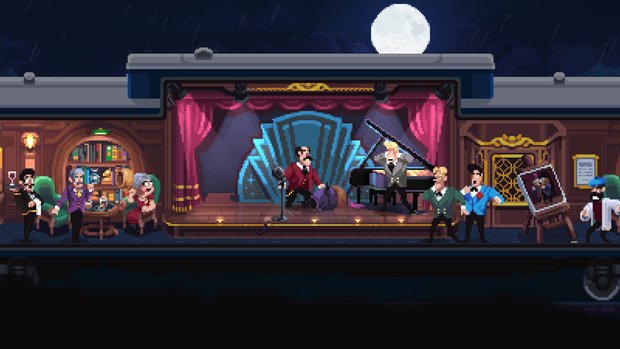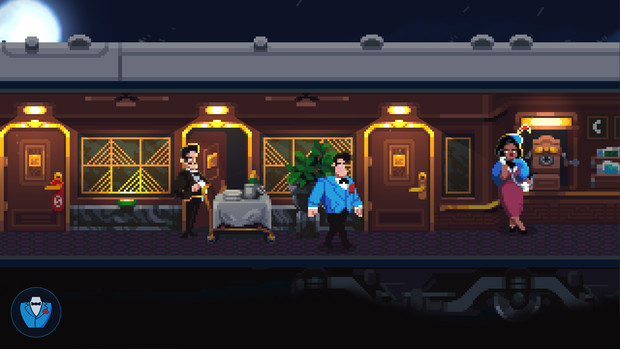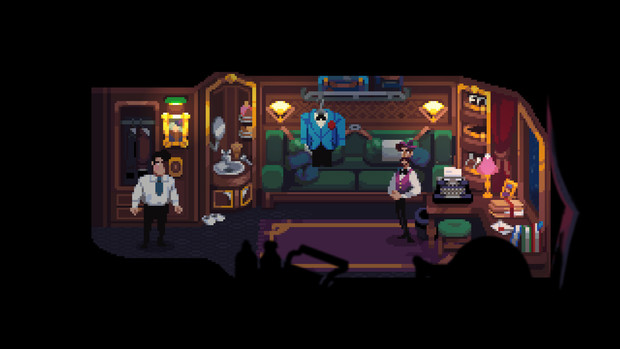Loco Motive review

- 4 Comments
Gorgeous and hilarious adventure confidently charges full steam ahead on an unforgettable murder mystery ride
From the moment the title screen swooped down towards the Reuss Express through swirling clouds and cartoonish backdrops rivaled only by the original LucasArts classics, I knew I was in for a treat with Loco Motive. In the thirty years since the golden age of graphic adventure games, many attempts have been made to recapture the magic of playing one of these masterpieces for the first time. While many were fun to play and perfectly fine in their own right, there was something missing in most that I couldn’t fully put my finger on. Impressively, with their first game, developer Robust Games has achieved the impossible: they have found that magic. Loco Motive is an incredible adventure filled with memorable characters and some of the most beautiful animation I have ever seen in a pixel art game, and it wears its inspirations on its sleeve with pride while charting its own path onto the hallowed halls of adventure gaming’s all-time greats.
Loco Motive is a cartoon slapstick adventure where you will use your puzzle-solving skills to investigate a murder mystery over the course of its 10-12 hour runtime. You begin the game as Arthur A. Ackerman, estate lawyer to Lady Unterwald who is the current head of the railway empire that built the train where you will spend the majority of your time exploring. Arthur is a well-meaning goofball, and he adores boring paperwork and the wonderful world of bureaucracy. As she’s getting up in age, Lady Unterwald invites Arthur aboard the Reuss Express to help her with some last-minute edits to her will before a big speech she is planning, in order to let the rest of her extended family know what she intends to do with the railway empire once she dies. It’s a good thing she had her will updated too, as shortly after she begins her speech, the train goes through a dark tunnel, casting everything in complete darkness. When it emerges, Lady Unterwald lies dying on the floor! For reasons as yet unbeknownst to you, Arthur and the other two playable characters are the prime suspects of this dastardly crime, and it’s up to you to clear their names and find the real killer!

At its core, Loco Motive is a traditional point-and-click adventure game that sticks to the basics. You can use left and right clicks to interact with objects in the environment, along with picking things up or talking with other characters, while the TAB key will highlight any hotspots in the environment. Holding down the left mouse button causes your character to run, which is a godsend when a large part of the game will have you running back and forth through side-scrolling train cars to talk to people and solve puzzles. The game features full direct control options on any modern gamepad as well, with a surprising amount of customization options for both control and audio/video displays (including a dyslexic mode and the ability to change font size and speed). Any items you find will be accessible in your character inventory, which is denoted by a small suit icon at the bottom left of the screen at all times during gameplay.
Over the course of the game, you will take on the role of three distinct characters – the previously introduced Arthur A. Ackerman, the bumbling self-proclaimed detective and mystery novelist Herman Merman, and the mysterious spy Diana Osterhagen. Each is introduced in a police precinct, where they are being grilled by two police detectives about their possible motivations for murdering Lady Unterwald, which sets the stage for them to give their own account of the events that transpired over the course of that fateful day. The game is divided into chapters, with each person’s section taking place over the course of roughly two chapters each. Their sections start at different points in the story, though, which fills in gaps in the others’ perspectives and builds up to a clearer picture. It’s an incredibly clever way to carry the story forward with small breadcrumbs that lead to bigger reveals further along.

One of my favorite examples of this is with a very special character called Agent M – you meet them relatively early on in the game, but each time you think you fully understand everything about them you find a new detail that adds another layer on top the next time you learn about the day’s events from another protagonist’s perspective. Or in Arthur’s section, you might find yourself walking into the train’s kitchen car only to get shooed out by some angry chefs dealing with some kind of mess you heard was caused earlier in the day – and when you play as one of the others giving their account of events, you might get to see who or what was the cause. This keeps traversing the same locations fresh through the relatively tight spaces on the Reuss Express, and it makes each new visit to a room you’ve been to dozens of times before a joy rather than dull repetition.
Backgrounds are painstakingly detailed and every room you encounter feels distinct. And suitably for a game set on a moving train, Loco Motive is gorgeous to witness in motion – screenshots don’t do the meticulously detailed pixel art animations justice. Arthur will nervously shift his fingers around while standing idly, and when running you’ll notice the slightest bobbing of his hair. Each character has a distinct style of movement: Arthur has a light jog, while Diana launches her feet forward with each bound like the trained agent she is. Even if there was no written dialogue, you’d immediately be able to tell the kind of people these characters are through their body language and how they carry themselves through the environment.
At various points you will witness a close-up of one of the characters emoting in some way, and many of these made me burst out laughing at how hilarious they are. A couple examples are the camera zooming in on Herman giving a face of absolute horror after he accidentally goes a bit too hard on a game involving a knife, or the Gudrun twins zooming in toward you with their faces all squished together and their beady little eyes blinking outward from the screen. Several puzzles require you to combine items in your inventory before using them in the game world, and every one of these item combinations plays out a full animation of the character combining the two. If there’s any action to perform in the game, you can bet there’s going to be a full animation that accompanies it. You really feel the love poured into every tiny detail of the design, and every interaction oozes charm.
Equally impressive is Loco Motive’s incredible jazz soundtrack. The swanky score crescendos along with high intensity scenes, all the while grounding the game’s setting in its 1930s atmosphere. Every track feels like it’s being played by the live band performing on the train, which adds to the high-class vibe of the Reuss Express. The rest of the sound design similarly gives every movement and interaction its own sense of character – there’s just something timelessly funny about someone stretching their pants to shove down a huge object they picked up, along with a corresponding stretch and crash of dropping whatever was picked up into their inventory.

Every character is incredibly well performed by the talented voice cast, with plenty of suitably over-the-top performances that play into the zany tone of the cartoon murder mystery. Most interactions with people are handled through one or two lines of dialogue listed onscreen above character heads while they are speaking, but some conversations open up dialogue trees at the bottom of the screen where you are able to choose from a variety of responses or lines of inquiry. While none of these choices have any real effect on the ultimate outcome of the game, it allows for some really fun responses to character dialogues that flesh out the characters and this world more than a one-word line of text popping above a character’s head.
Playing through Loco Motive, there are quite a few challenging conundrums you’ll have to solve to progress. It’s no Sierra On-Line adventure, but there were multiple points in the game where I was genuinely stumped for a solid chunk of time. One task requires you to find an idol of a human hand making a specific gesture from out of a multitude of hand-related idols, based on clues found elsewhere around the train. I won’t spoil the solution, but these kinds of natural logic progressions are commonplace, and most puzzles are intuitively clued with enough context that you’ll be able to find a solution with a bit of thought and experimentation. On occasion a multi-level solution can be a bit out there, however. Another section requires you to win a game of five finger fillet (or “Knifey Stab Stab” as it is hilariously referred to) against another character. Immediately I figured I would need to make the knife slippery in order to claim victory, and when I’d done that, naturally I assumed that was that and went to play another round. My opponent made a remark about the blade being more slippery than usual, but he continued to wipe the floor with me and I lost just like before. It was only after a lot of trial and error that I found out there was another way to make the knife even more slippery, and only then was I victorious.
Thankfully, there’s a built-in hint system where you can walk up to any telephone on the train and call in to a hint line. The hints are provided by in-universe ace detective Dirk Chiselton. (Dirk is so good at his job that in addition to taking up normal detective work, he also runs the hint service on the Reuss Express.) Hilariously, Herman will constantly bemoan his archrival Dirk being the one providing hints on how to solve a particularly difficult puzzle, but every time Dirk will respond with overwhelming genuine kindness, encouraging you to just say the word if you need any more help. Clearly Herman’s rivalry is entirely one-sided. Dirk’s hint system is great at providing just enough information to give you a general idea of what to do next without completely spoiling the coveted “Eureka!” moments every adventure puzzler strives for. There are multiple levels to each hint you can ask for – if the most generic one isn’t enough, there are a couple more specifics Dirk can provide to get you back on track. I never felt like the game was holding my hand with this system, and it allowed for some fun experimentation that eventually led to a solution.
Throughout the game, the cartoon zaniness and focus on three playable characters to solve puzzles elicited feelings of a certain classic adventure involving a diabolical tentacle, but during the last third of the game the mask comes completely off: Loco Motive goes full Day of the Tentacle after a major plot event, and from that moment on you’ll be controlling all three characters simultaneously, switching between them at will. This felt like a natural progression of the puzzles, and the last third of the game really served to test my knowledge on how to use the three protagonists to find a solution. There’s a rather blatant nod in the manner used to transport items between the characters that had me grinning like an idiot when I got to it, and I certainly won’t spoil anything about this so you can experience that same joy I did in discovering if for yourself. My one gripe is that it’s only in this last third that you finally get to control Diana. While she is playable for the remainder of the game from that point on, it is a bummer she didn’t have an entire solo section before that like Arthur and Herman, who had an entire two or more chapters each. Every character’s portrayal is so strong that I would have enjoyed seeing a bit more of Diana performing espionage without the rest of the trio before coming together for the big finish, but this is ultimately a small nitpick.
Final Verdict
Loco Motive is an absolute joy to play in every aspect. The sense of movement in the flow of art and character animation perfectly complements the nonstop forward momentum of the express train you explore, along with the incredible high energy jazz score. The passengers and crew of the Reuss Express are all wonderfully fun to interact with, and several individuals go through some surprising character development over the course of the experience. (Agent M and the sleazebag gangster Donny both come to mind.) Plenty of well-designed head scratchers will keep even the most experienced of adventure gamers on their toes, and even if you’re a newcomer to the genre, there are helpful guiding hands to assist you along. I even went back and called the in-game hint service at times when I didn’t need a hint because of how entertaining Dirk’s dialogue is. Loco Motive might have started out as a loving homage to the classics of the past, but it’s so much more than just a trip down memory lane. This is one train ride everyone needs to take.
Hot take
Loco Motive is the full package. Grab a ticket, put on your thinking cap, and hop on the Reuss Express, as this is one of the finest cartoon point-and-click adventures ever created.
Pros
- Beautiful pixel art animation, memorable jazz score and top-notch voice performances
- Tough but fair puzzles that lead to some real “Eureka!” moments
- Genuinely funny dialogue and some of the best prop comedy in the genre
- Lengthy runtime without feeling drawn out
Cons
- Not enough of Diana’s solo story
Sam played Loco Motive on PC using a review code provided by the game's publisher.











4 Comments
Want to join the discussion? Leave a comment as guest, sign in or register.
I was about to buy this game, then read a review stating that it still had rough edges. Things like punctuation and spelling errors, as well as the text sometimes wandering off the edges of the screen, or missing text because the screen scrolled away whilst it was being displayed elsewhere in the scene. Did you encounter any of this? This game sounds like one I'd really enjoy, but if it's still got noticeable wrinkles, I'd be happy to wait until they are ironed out.
Reply
I was really excited when I first started playing Loco Motion. The story idea is cool and it seems strong at the beginning. The voice acting is also very good and made me want to keep going. But after a while, I ran into so many bugs and puzzles that made no sense that I just gave up. The game is not fun to play. I couldn’t even finish it because it was too frustrating. It’s a shame because it had a lot of potential, but as a game, it’s just bad.
Reply
Pros: The game succeeds in replicating that classic LucasArts feel. The writing is consistently funny with interesting characters (Herman Merman the bumbling detective being the stand out). The game has very high quality pixel art and animations with subtle lighting changes. The voice acting is superb with a well rounded cast. Compared to other nostalgia aimed adventure games released in 2024, this one ranks very high overall. Cons: Puzzles are too easy (especially if you've played a few 90s era adventure games) and the runtime is therefore padded out with lots of dialogue. Since the mystery is fairy light and predictable, I ended up skipping through this in later acts by reading the subtitles before the voice actor had finished (it was obvious what the puzzle solution would be before the puzzle was introduced). Splitting the story up between three characters over the same timeline hurts the pacing somewhat with later sections being progressively weaker, despite some classic character switching and team ups (à la Day of the Tentacle). 3rd protagonist Diana felt unnecessary and underdeveloped with the writers maybe afraid to give her any flaws compared to Arthur/Herman. A lot of musical homages but perhaps not original enough (Monkey Islandesque themes, Full Throttle reference and almost note for note Leisure Suit Larry theme). I didn't encounter many bugs so maybe most issues have been ironed out. Just two I can remember: an animation not triggering after a voice line and having to reload an old save; a character walking over art that was supposed to be in front of them.
Reply
First 90 minutes in, there seems to be no actual puzzle yet, just exploration, dialogue and folllowing hints from dialogs. In terms execution it looks brilliant so far but it does not create that fun secret bond of smartness between the creator and me yet.
Reply
Leave a comment